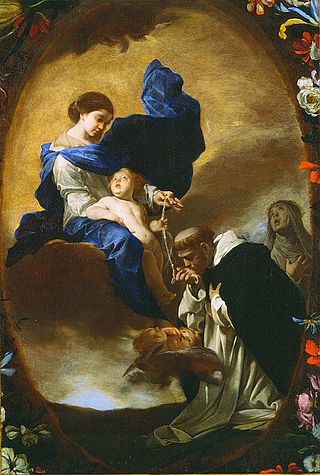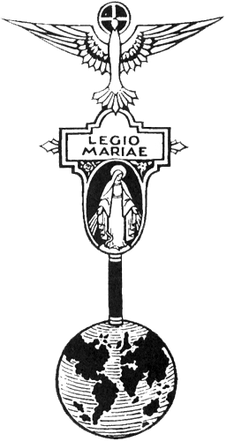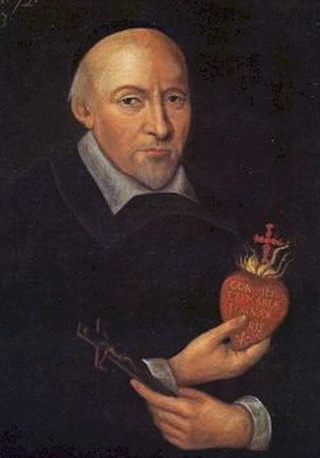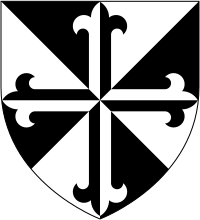
The Rosary, also known as the Dominican Rosary, refers to a set of prayers used primarily in the Catholic Church, and to the physical string of knots or beads used to count the component prayers. When referring to the prayer, the word is usually capitalized ; when referring to the prayer beads as an object, it is written with a lower-case initial letter.

The Most Sacred Heart of Jesus is one of the most widely practised and well-known Catholic devotions, wherein the heart of Jesus Christ is viewed as a symbol of "God's boundless and passionate love for mankind". This devotion to Christ is predominantly used in the Catholic Church, followed by high church Anglicans, and some Western Rite Orthodox. In the Latin Church, the liturgical Solemnity of the Most Sacred Heart of Jesus is celebrated the third Friday after Pentecost. The 12 promises of the Most Sacred Heart of Jesus are also popular.

The First Saturdays Devotion, also called the Act of Reparation to the Immaculate Heart of the Blessed Virgin Mary, is a Catholic devotion which, according to Sister Lúcia of Fátima, was requested by the Virgin Mary in an apparition at Pontevedra, Spain, in December 1925.

The Scapular of Our Lady of Mount Carmel belongs to the habit of both the Carmelite Order and the Discalced Carmelite Order, both of which have Our Lady of Mount Carmel as their patroness. In its small form, it is widely popular within the Latin Church of the Catholic Church as a religious article and has probably served as the prototype of all the other devotional scapulars. The liturgical feast day of Our Lady of Mount Carmel, July 16, is popularly associated with the devotion of the Scapular.
The Passionists, officially named the Congregation of the Passion of Jesus Christ, abbreviated CP, are a Catholic clerical religious congregation of pontifical right for men, founded by Paul of the Cross in 1720, with a special emphasis on and devotion to the Passion of Jesus Christ. A known symbol of the congregation is the labeled emblem of the Sacred Heart of Jesus, surmounted by a cross. This symbol is often sewn into the attire of its congregants.

The Legion of Mary is an international association of members of the Catholic Church who serve on a voluntary basis. It was founded in Dublin, as a Marian movement by the layman and civil servant Frank Duff.

The Blue Army of Our Lady of Fátima, now mostly known as the World Apostolate of Fátima, is a public international association that has as its general purpose "the promotion of the authentic teaching of the Catholic Church and the strict adherence to the tenets of the Gospel; the personal sanctification of adherents through faithful adherence to the Message of Our Lady of Fátima and the promotion of the common good by the spreading of that Message of Fátima".

The Congregation of Marian Fathers of the Immaculate Conception of the Most Blessed Virgin Mary is a Catholic male clerical religious congregation founded, 1670, in Poland. It is also known as Marians of the Immaculate Conception. Its members add the post-nominal letters M.I.C. after their names to indicate membership in the Congregation.

John Eudes, CIM was a French Catholic priest and the founder of both the Order of Our Lady of Charity in 1641 and Congregation of Jesus and Mary, also known as The Eudists, in 1643. He was also a professed member of the Oratory of Jesus until 1643.

Catholic devotions are particular customs, rituals, and practices of worship of God or honour of the saints which are in addition to the liturgy of the Catholic Church. The United States Conference of Catholic Bishops describes devotions as "expressions of love and fidelity that arise from the intersection of one's own faith, culture and the Gospel of Jesus Christ". Devotions are not considered part of liturgical worship, even if they are performed in a church or led by a priest, but rather they are paraliturgical. The Congregation for Divine Worship at the Vatican publishes a Directory on Popular Piety and the Liturgy.
Purgatorial societies are Roman Catholic Church associations or confraternities which aim to assist souls in purgatory reach heaven. The doctrine concerning purgatory, the condition of the poor souls after death, the communion of saints, and the satisfactory value of our good works form the basis of these associations.

The Third Order of Saint Dominic, also referred to as the Lay Fraternities of Saint Dominic or Lay Dominicans since 1972, is a Catholic third order which is part of the Dominican Order.
The Confraternity of the Holy Rosary is a Roman Catholic Archconfraternity or spiritual association, under the care and guidance of the Dominican Order. The members of the confraternity strive to pray the entire Holy Rosary weekly.

Reparation is a Christian theological concept closely connected with those of atonement and satisfaction. In ascetical theology, reparation is the making of amends for insults given to God through sin, either one's own or another's. The response of man is to be reparation through adoration, prayer, and sacrifice. In Roman Catholic tradition, an act of reparation is a prayer or devotion with the intent to expiate the "sins of others", e.g. for the repair of the sin of blasphemy, the sufferings of Jesus Christ or as Acts of Reparation to the Virgin Mary.

Catholic Marian movements and societies have developed from the veneration of the Blessed Virgin Mary by members of the Catholic Church. These societies form part of the fabric of Mariology in the Catholic Church. Popular membership in Marian organizations grew significantly in the 20th century, as apparitions such as Our Lady of Fátima gave rise to societies with millions of members, and today many Marian societies exist around the world. This article reviews the major Marian movements and organizations.

There are differing views on the history of the rosary, a Christian prayer rope, cord or chain used to count specific prayers, commonly as a Marian devotion. The exact origin of the rosary as a prayer is less than clear and subject to debate among scholars. The use of knotted prayer ropes in Christianity goes back to the Desert Fathers in the 3rd and early 4th centuries. These counting devices were used for prayers such as the Jesus Prayer in Christian monasticism. The period after the Council of Ephesus in 431 witnessed gradual growth in the use of Marian prayers during the Middle Ages.

The Dominican Order was first established in the United States by Edward Fenwick in the early 19th century. The first Dominican institution in the United States was the Province of Saint Joseph, which was established in 1805. Additionally, there have been numerous institutes of Dominican Sisters and Nuns.
Worldwide The Confraternity of the Immaculate Conception of the Blessed Virgin Mary is one of the oldest lay apostolates still operating in the Roman Catholic Church, having been part of the Congregation of the Marians of the Immaculate Conception founded by Stanislaw Papczynski. "The Blessed Marian Founder fervently encouraged his spiritual sons to establish confraternities of the Immaculate Conception at Marian churches. 'The first laws of the Order of 1694-1698 speak of this already."

Our Lady of Consolation or Mary, Comforter of the Afflicted is a title of the Blessed Virgin Mary venerated in the Catholic Church.















